Analysis of Telehealth Facilities: Nursing, Benefits, and Tools Used
VerifiedAdded on 2021/04/17
|7
|1395
|31
Essay
AI Summary
This essay provides a comprehensive overview of tele-healthcare facilities, exploring the technologies and practices used to deliver virtual health services. It defines tele-healthcare and tele-nursing, highlighting the synchronized and asynchronized modalities through which care is provided. The essay discusses the positive aspects of tele-healthcare, such as convenience, accessibility, and cost reduction, as well as the negative aspects, including lack of training and potential for technological interruptions. It identifies essential tools for telehealth services, including broadband connections, hardware, and electronic medical records. Furthermore, the essay examines the populations that benefit most from telehealth, such as urban residents, individuals in remote locations, those with lower socio-economic status, and people affected by natural disasters. The essay concludes by referencing relevant studies and literature that support the analysis of telehealth services.
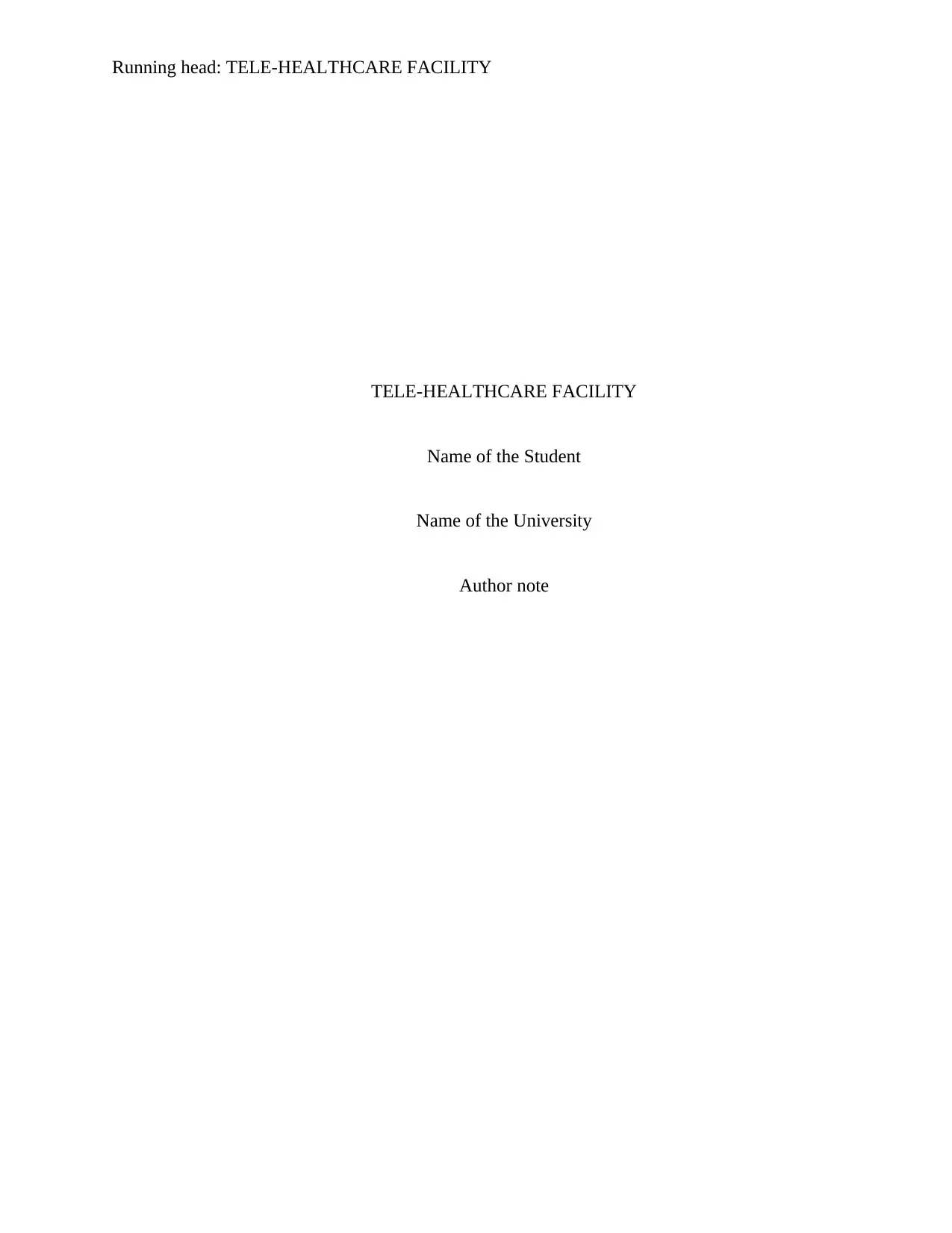
Running head: TELE-HEALTHCARE FACILITY
TELE-HEALTHCARE FACILITY
Name of the Student
Name of the University
Author note
TELE-HEALTHCARE FACILITY
Name of the Student
Name of the University
Author note
Paraphrase This Document
Need a fresh take? Get an instant paraphrase of this document with our AI Paraphraser
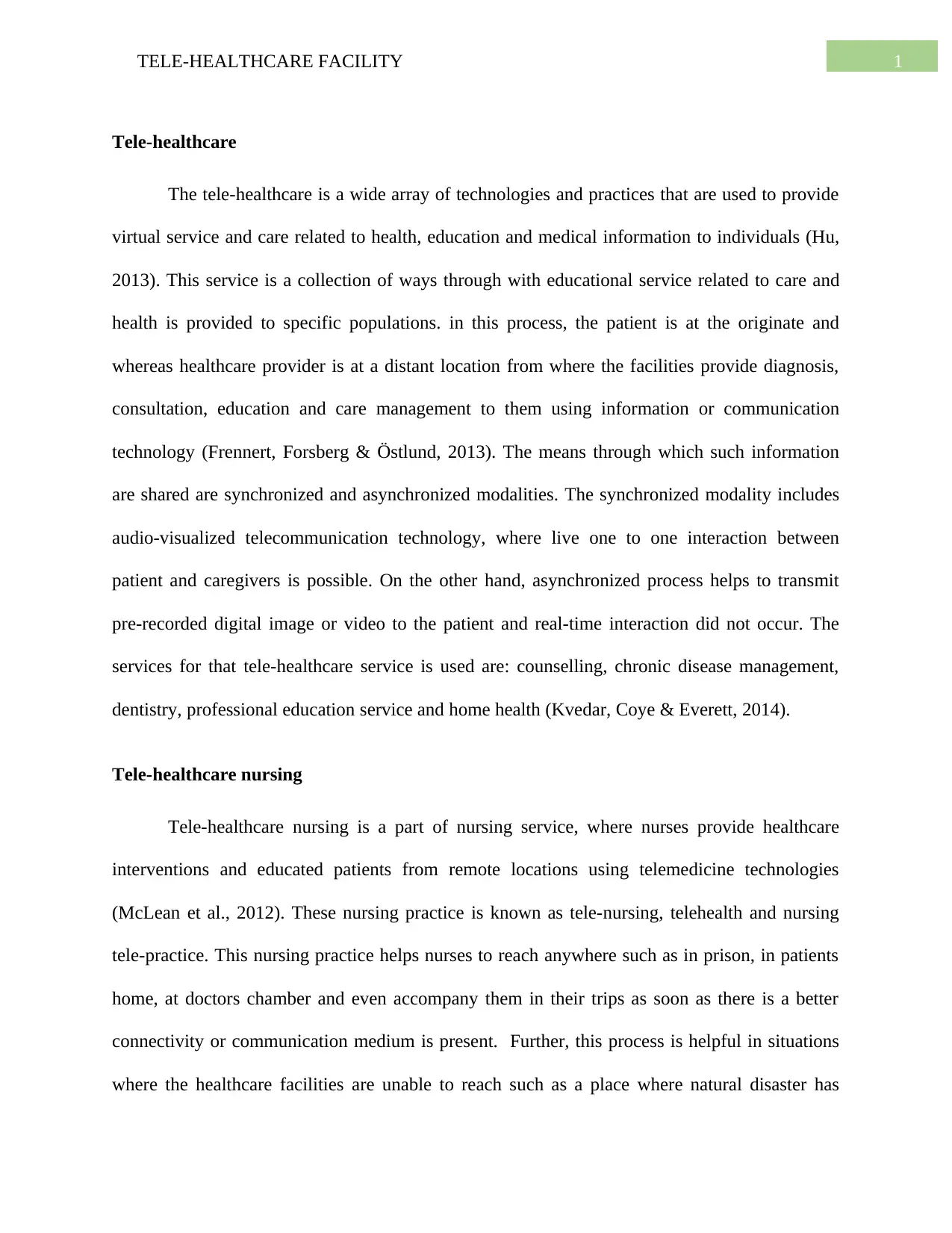
1TELE-HEALTHCARE FACILITY
Tele-healthcare
The tele-healthcare is a wide array of technologies and practices that are used to provide
virtual service and care related to health, education and medical information to individuals (Hu,
2013). This service is a collection of ways through with educational service related to care and
health is provided to specific populations. in this process, the patient is at the originate and
whereas healthcare provider is at a distant location from where the facilities provide diagnosis,
consultation, education and care management to them using information or communication
technology (Frennert, Forsberg & Östlund, 2013). The means through which such information
are shared are synchronized and asynchronized modalities. The synchronized modality includes
audio-visualized telecommunication technology, where live one to one interaction between
patient and caregivers is possible. On the other hand, asynchronized process helps to transmit
pre-recorded digital image or video to the patient and real-time interaction did not occur. The
services for that tele-healthcare service is used are: counselling, chronic disease management,
dentistry, professional education service and home health (Kvedar, Coye & Everett, 2014).
Tele-healthcare nursing
Tele-healthcare nursing is a part of nursing service, where nurses provide healthcare
interventions and educated patients from remote locations using telemedicine technologies
(McLean et al., 2012). These nursing practice is known as tele-nursing, telehealth and nursing
tele-practice. This nursing practice helps nurses to reach anywhere such as in prison, in patients
home, at doctors chamber and even accompany them in their trips as soon as there is a better
connectivity or communication medium is present. Further, this process is helpful in situations
where the healthcare facilities are unable to reach such as a place where natural disaster has
Tele-healthcare
The tele-healthcare is a wide array of technologies and practices that are used to provide
virtual service and care related to health, education and medical information to individuals (Hu,
2013). This service is a collection of ways through with educational service related to care and
health is provided to specific populations. in this process, the patient is at the originate and
whereas healthcare provider is at a distant location from where the facilities provide diagnosis,
consultation, education and care management to them using information or communication
technology (Frennert, Forsberg & Östlund, 2013). The means through which such information
are shared are synchronized and asynchronized modalities. The synchronized modality includes
audio-visualized telecommunication technology, where live one to one interaction between
patient and caregivers is possible. On the other hand, asynchronized process helps to transmit
pre-recorded digital image or video to the patient and real-time interaction did not occur. The
services for that tele-healthcare service is used are: counselling, chronic disease management,
dentistry, professional education service and home health (Kvedar, Coye & Everett, 2014).
Tele-healthcare nursing
Tele-healthcare nursing is a part of nursing service, where nurses provide healthcare
interventions and educated patients from remote locations using telemedicine technologies
(McLean et al., 2012). These nursing practice is known as tele-nursing, telehealth and nursing
tele-practice. This nursing practice helps nurses to reach anywhere such as in prison, in patients
home, at doctors chamber and even accompany them in their trips as soon as there is a better
connectivity or communication medium is present. Further, this process is helpful in situations
where the healthcare facilities are unable to reach such as a place where natural disaster has
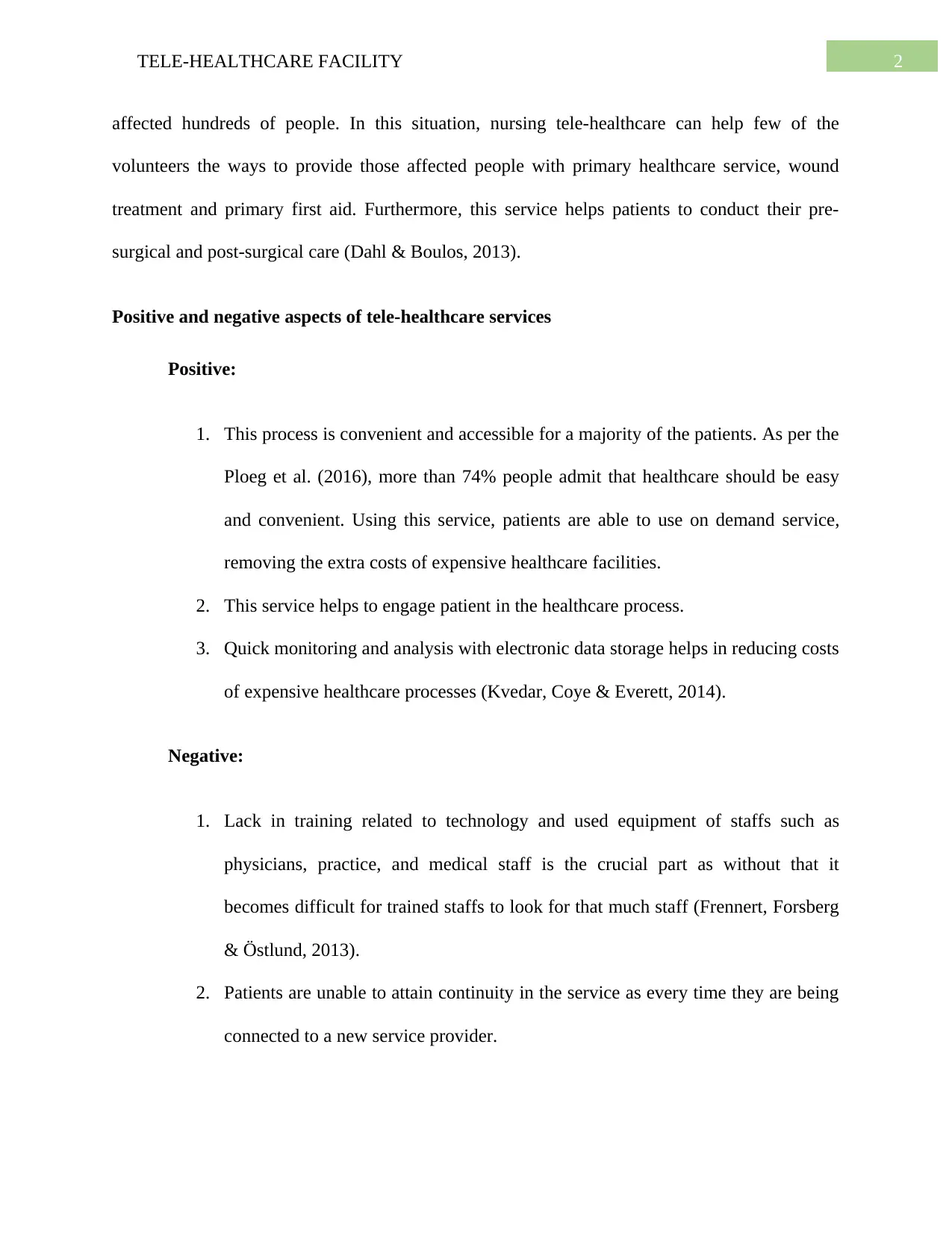
2TELE-HEALTHCARE FACILITY
affected hundreds of people. In this situation, nursing tele-healthcare can help few of the
volunteers the ways to provide those affected people with primary healthcare service, wound
treatment and primary first aid. Furthermore, this service helps patients to conduct their pre-
surgical and post-surgical care (Dahl & Boulos, 2013).
Positive and negative aspects of tele-healthcare services
Positive:
1. This process is convenient and accessible for a majority of the patients. As per the
Ploeg et al. (2016), more than 74% people admit that healthcare should be easy
and convenient. Using this service, patients are able to use on demand service,
removing the extra costs of expensive healthcare facilities.
2. This service helps to engage patient in the healthcare process.
3. Quick monitoring and analysis with electronic data storage helps in reducing costs
of expensive healthcare processes (Kvedar, Coye & Everett, 2014).
Negative:
1. Lack in training related to technology and used equipment of staffs such as
physicians, practice, and medical staff is the crucial part as without that it
becomes difficult for trained staffs to look for that much staff (Frennert, Forsberg
& Östlund, 2013).
2. Patients are unable to attain continuity in the service as every time they are being
connected to a new service provider.
affected hundreds of people. In this situation, nursing tele-healthcare can help few of the
volunteers the ways to provide those affected people with primary healthcare service, wound
treatment and primary first aid. Furthermore, this service helps patients to conduct their pre-
surgical and post-surgical care (Dahl & Boulos, 2013).
Positive and negative aspects of tele-healthcare services
Positive:
1. This process is convenient and accessible for a majority of the patients. As per the
Ploeg et al. (2016), more than 74% people admit that healthcare should be easy
and convenient. Using this service, patients are able to use on demand service,
removing the extra costs of expensive healthcare facilities.
2. This service helps to engage patient in the healthcare process.
3. Quick monitoring and analysis with electronic data storage helps in reducing costs
of expensive healthcare processes (Kvedar, Coye & Everett, 2014).
Negative:
1. Lack in training related to technology and used equipment of staffs such as
physicians, practice, and medical staff is the crucial part as without that it
becomes difficult for trained staffs to look for that much staff (Frennert, Forsberg
& Östlund, 2013).
2. Patients are unable to attain continuity in the service as every time they are being
connected to a new service provider.
⊘ This is a preview!⊘
Do you want full access?
Subscribe today to unlock all pages.

Trusted by 1+ million students worldwide
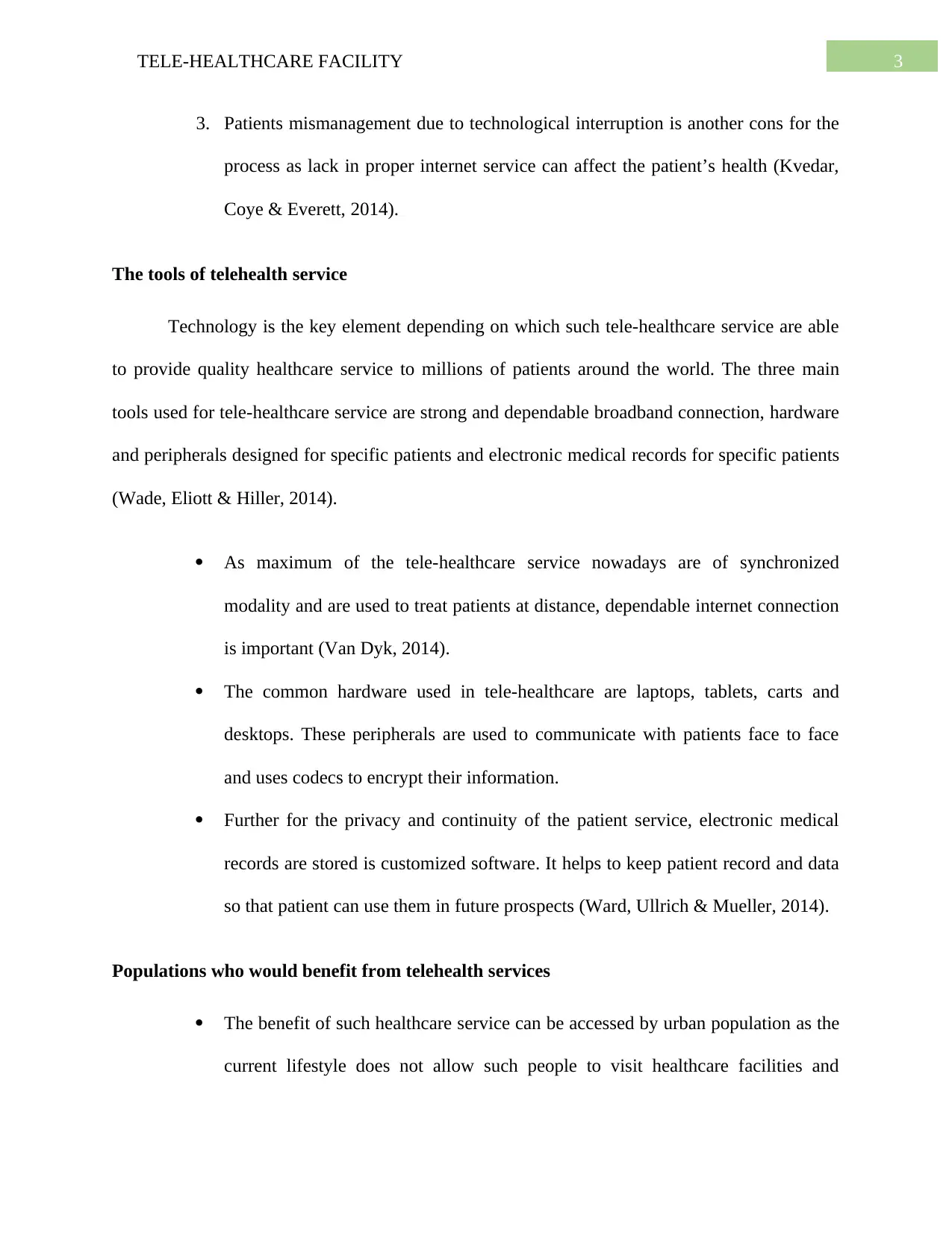
3TELE-HEALTHCARE FACILITY
3. Patients mismanagement due to technological interruption is another cons for the
process as lack in proper internet service can affect the patient’s health (Kvedar,
Coye & Everett, 2014).
The tools of telehealth service
Technology is the key element depending on which such tele-healthcare service are able
to provide quality healthcare service to millions of patients around the world. The three main
tools used for tele-healthcare service are strong and dependable broadband connection, hardware
and peripherals designed for specific patients and electronic medical records for specific patients
(Wade, Eliott & Hiller, 2014).
As maximum of the tele-healthcare service nowadays are of synchronized
modality and are used to treat patients at distance, dependable internet connection
is important (Van Dyk, 2014).
The common hardware used in tele-healthcare are laptops, tablets, carts and
desktops. These peripherals are used to communicate with patients face to face
and uses codecs to encrypt their information.
Further for the privacy and continuity of the patient service, electronic medical
records are stored is customized software. It helps to keep patient record and data
so that patient can use them in future prospects (Ward, Ullrich & Mueller, 2014).
Populations who would benefit from telehealth services
The benefit of such healthcare service can be accessed by urban population as the
current lifestyle does not allow such people to visit healthcare facilities and
3. Patients mismanagement due to technological interruption is another cons for the
process as lack in proper internet service can affect the patient’s health (Kvedar,
Coye & Everett, 2014).
The tools of telehealth service
Technology is the key element depending on which such tele-healthcare service are able
to provide quality healthcare service to millions of patients around the world. The three main
tools used for tele-healthcare service are strong and dependable broadband connection, hardware
and peripherals designed for specific patients and electronic medical records for specific patients
(Wade, Eliott & Hiller, 2014).
As maximum of the tele-healthcare service nowadays are of synchronized
modality and are used to treat patients at distance, dependable internet connection
is important (Van Dyk, 2014).
The common hardware used in tele-healthcare are laptops, tablets, carts and
desktops. These peripherals are used to communicate with patients face to face
and uses codecs to encrypt their information.
Further for the privacy and continuity of the patient service, electronic medical
records are stored is customized software. It helps to keep patient record and data
so that patient can use them in future prospects (Ward, Ullrich & Mueller, 2014).
Populations who would benefit from telehealth services
The benefit of such healthcare service can be accessed by urban population as the
current lifestyle does not allow such people to visit healthcare facilities and
Paraphrase This Document
Need a fresh take? Get an instant paraphrase of this document with our AI Paraphraser
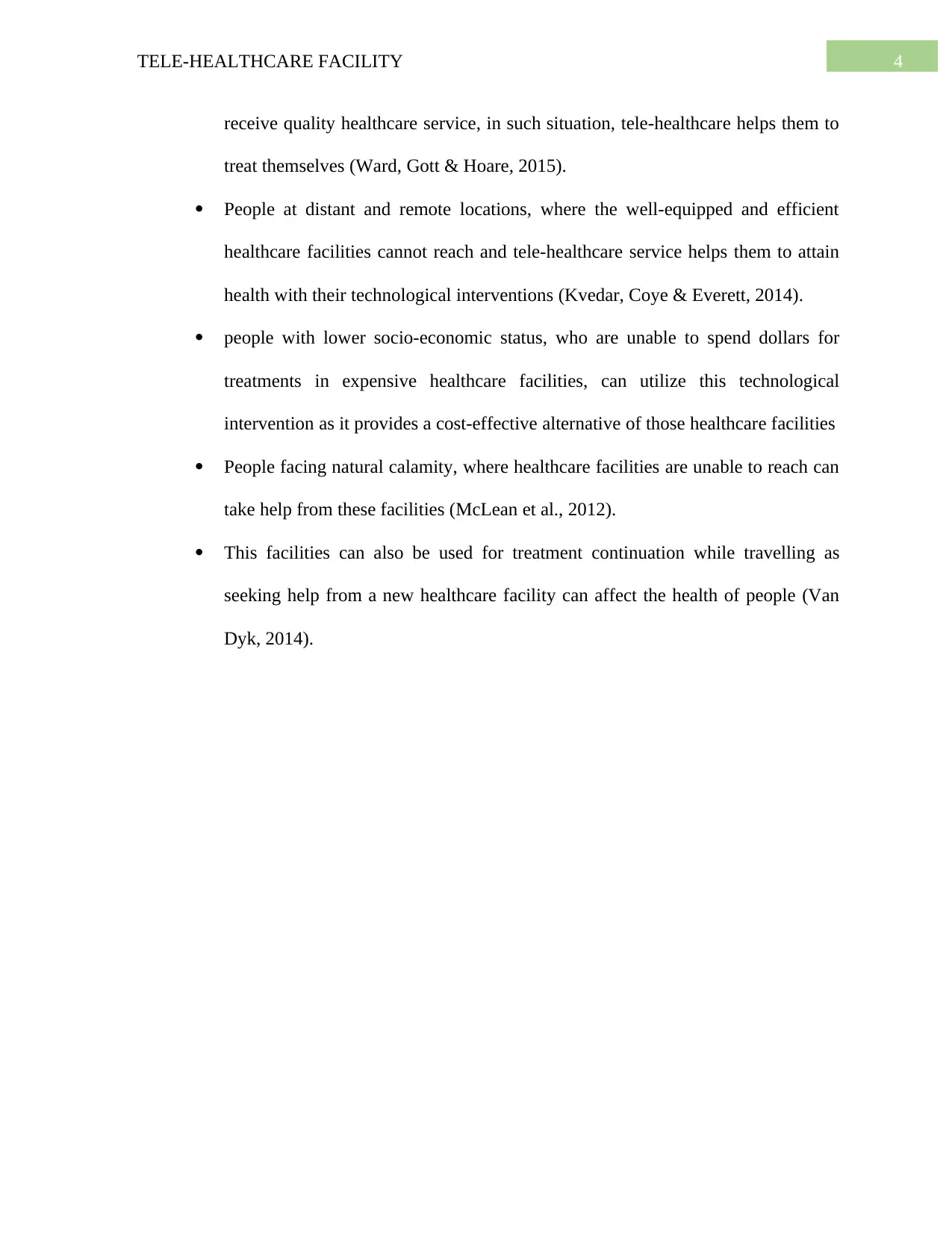
4TELE-HEALTHCARE FACILITY
receive quality healthcare service, in such situation, tele-healthcare helps them to
treat themselves (Ward, Gott & Hoare, 2015).
People at distant and remote locations, where the well-equipped and efficient
healthcare facilities cannot reach and tele-healthcare service helps them to attain
health with their technological interventions (Kvedar, Coye & Everett, 2014).
people with lower socio-economic status, who are unable to spend dollars for
treatments in expensive healthcare facilities, can utilize this technological
intervention as it provides a cost-effective alternative of those healthcare facilities
People facing natural calamity, where healthcare facilities are unable to reach can
take help from these facilities (McLean et al., 2012).
This facilities can also be used for treatment continuation while travelling as
seeking help from a new healthcare facility can affect the health of people (Van
Dyk, 2014).
receive quality healthcare service, in such situation, tele-healthcare helps them to
treat themselves (Ward, Gott & Hoare, 2015).
People at distant and remote locations, where the well-equipped and efficient
healthcare facilities cannot reach and tele-healthcare service helps them to attain
health with their technological interventions (Kvedar, Coye & Everett, 2014).
people with lower socio-economic status, who are unable to spend dollars for
treatments in expensive healthcare facilities, can utilize this technological
intervention as it provides a cost-effective alternative of those healthcare facilities
People facing natural calamity, where healthcare facilities are unable to reach can
take help from these facilities (McLean et al., 2012).
This facilities can also be used for treatment continuation while travelling as
seeking help from a new healthcare facility can affect the health of people (Van
Dyk, 2014).
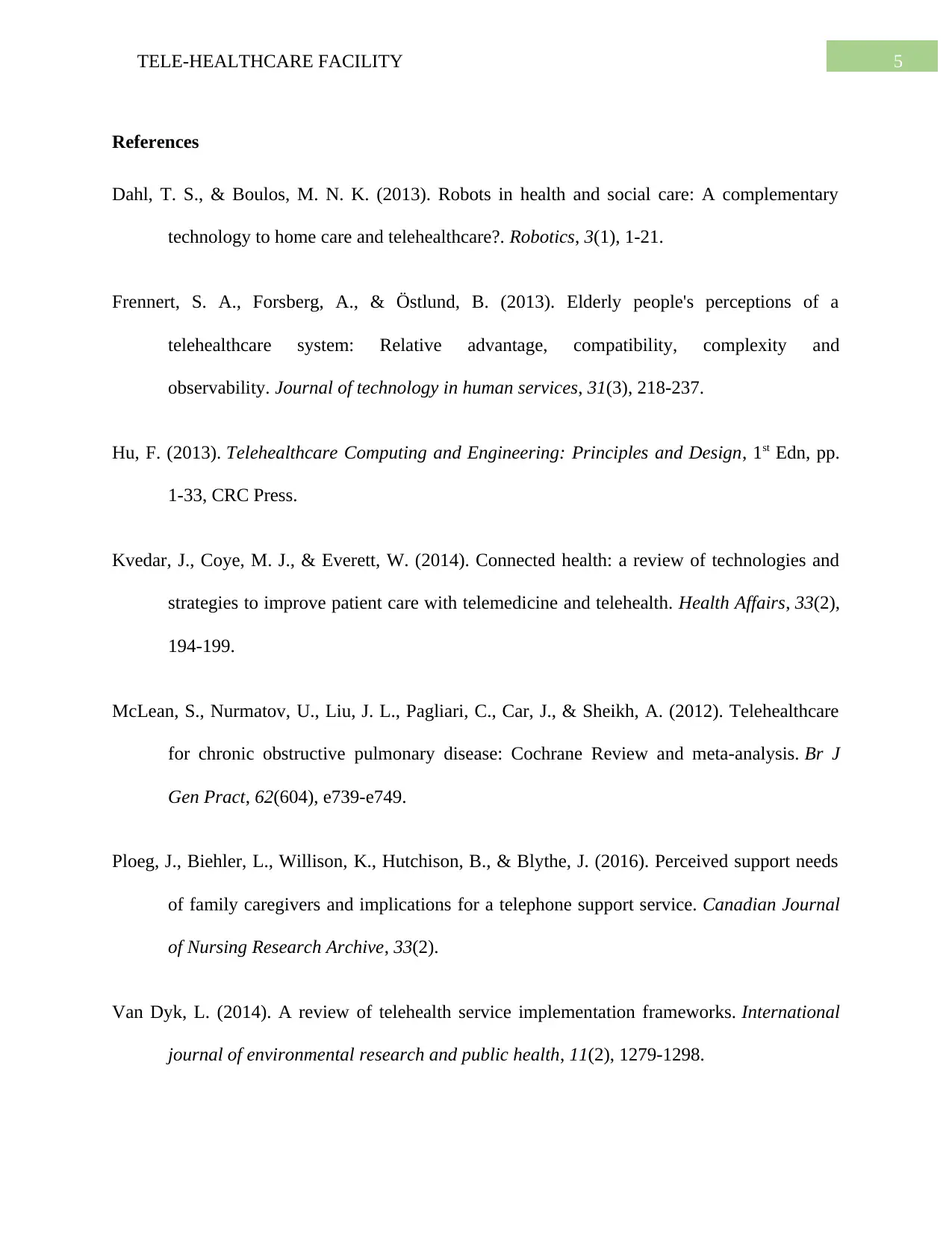
5TELE-HEALTHCARE FACILITY
References
Dahl, T. S., & Boulos, M. N. K. (2013). Robots in health and social care: A complementary
technology to home care and telehealthcare?. Robotics, 3(1), 1-21.
Frennert, S. A., Forsberg, A., & Östlund, B. (2013). Elderly people's perceptions of a
telehealthcare system: Relative advantage, compatibility, complexity and
observability. Journal of technology in human services, 31(3), 218-237.
Hu, F. (2013). Telehealthcare Computing and Engineering: Principles and Design, 1st Edn, pp.
1-33, CRC Press.
Kvedar, J., Coye, M. J., & Everett, W. (2014). Connected health: a review of technologies and
strategies to improve patient care with telemedicine and telehealth. Health Affairs, 33(2),
194-199.
McLean, S., Nurmatov, U., Liu, J. L., Pagliari, C., Car, J., & Sheikh, A. (2012). Telehealthcare
for chronic obstructive pulmonary disease: Cochrane Review and meta-analysis. Br J
Gen Pract, 62(604), e739-e749.
Ploeg, J., Biehler, L., Willison, K., Hutchison, B., & Blythe, J. (2016). Perceived support needs
of family caregivers and implications for a telephone support service. Canadian Journal
of Nursing Research Archive, 33(2).
Van Dyk, L. (2014). A review of telehealth service implementation frameworks. International
journal of environmental research and public health, 11(2), 1279-1298.
References
Dahl, T. S., & Boulos, M. N. K. (2013). Robots in health and social care: A complementary
technology to home care and telehealthcare?. Robotics, 3(1), 1-21.
Frennert, S. A., Forsberg, A., & Östlund, B. (2013). Elderly people's perceptions of a
telehealthcare system: Relative advantage, compatibility, complexity and
observability. Journal of technology in human services, 31(3), 218-237.
Hu, F. (2013). Telehealthcare Computing and Engineering: Principles and Design, 1st Edn, pp.
1-33, CRC Press.
Kvedar, J., Coye, M. J., & Everett, W. (2014). Connected health: a review of technologies and
strategies to improve patient care with telemedicine and telehealth. Health Affairs, 33(2),
194-199.
McLean, S., Nurmatov, U., Liu, J. L., Pagliari, C., Car, J., & Sheikh, A. (2012). Telehealthcare
for chronic obstructive pulmonary disease: Cochrane Review and meta-analysis. Br J
Gen Pract, 62(604), e739-e749.
Ploeg, J., Biehler, L., Willison, K., Hutchison, B., & Blythe, J. (2016). Perceived support needs
of family caregivers and implications for a telephone support service. Canadian Journal
of Nursing Research Archive, 33(2).
Van Dyk, L. (2014). A review of telehealth service implementation frameworks. International
journal of environmental research and public health, 11(2), 1279-1298.
⊘ This is a preview!⊘
Do you want full access?
Subscribe today to unlock all pages.

Trusted by 1+ million students worldwide
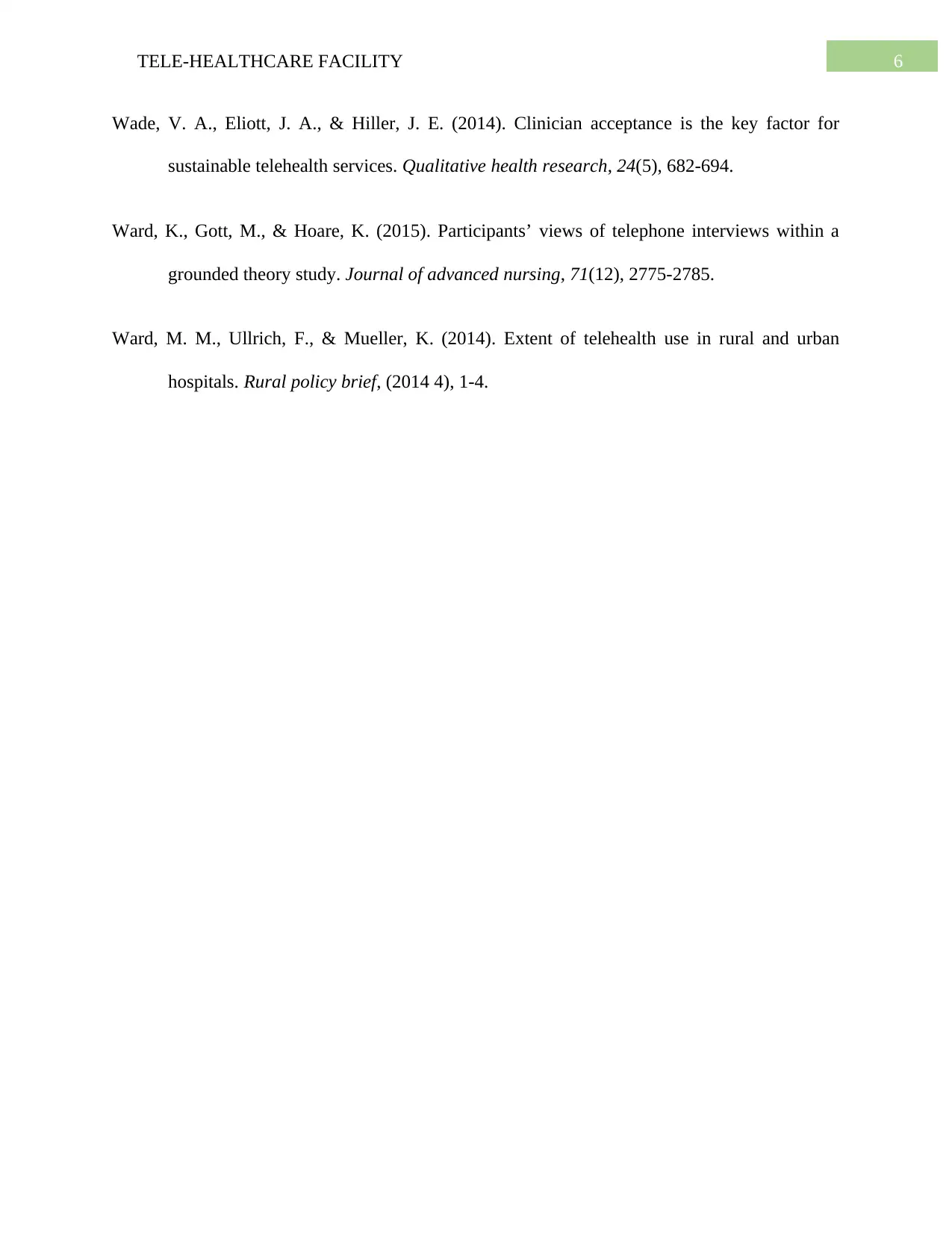
6TELE-HEALTHCARE FACILITY
Wade, V. A., Eliott, J. A., & Hiller, J. E. (2014). Clinician acceptance is the key factor for
sustainable telehealth services. Qualitative health research, 24(5), 682-694.
Ward, K., Gott, M., & Hoare, K. (2015). Participants’ views of telephone interviews within a
grounded theory study. Journal of advanced nursing, 71(12), 2775-2785.
Ward, M. M., Ullrich, F., & Mueller, K. (2014). Extent of telehealth use in rural and urban
hospitals. Rural policy brief, (2014 4), 1-4.
Wade, V. A., Eliott, J. A., & Hiller, J. E. (2014). Clinician acceptance is the key factor for
sustainable telehealth services. Qualitative health research, 24(5), 682-694.
Ward, K., Gott, M., & Hoare, K. (2015). Participants’ views of telephone interviews within a
grounded theory study. Journal of advanced nursing, 71(12), 2775-2785.
Ward, M. M., Ullrich, F., & Mueller, K. (2014). Extent of telehealth use in rural and urban
hospitals. Rural policy brief, (2014 4), 1-4.
1 out of 7
Related Documents
Your All-in-One AI-Powered Toolkit for Academic Success.
+13062052269
info@desklib.com
Available 24*7 on WhatsApp / Email
![[object Object]](/_next/static/media/star-bottom.7253800d.svg)
Unlock your academic potential
Copyright © 2020–2025 A2Z Services. All Rights Reserved. Developed and managed by ZUCOL.





